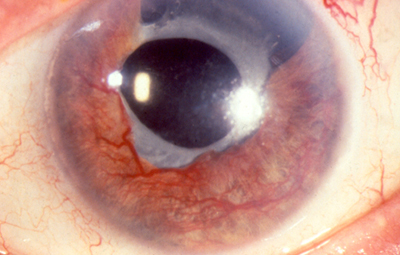Neovascular glaucoma is a particularly aggressive and difficult to treat kind of glaucoma. It is caused by new, small blood vessels growing in the front part of the eye. These neovascular vessels grow on the surface of the iris (the colored part of the eye) and over the drainage channel, blocking the flow of fluid from the eye. This causes a rapid and painful rise in pressure within the eye. This type of glaucoma often does not respond well to medical treatment, and the high intraocular pressure can lead to a rapid loss of vision.

Causes of neovascular glaucoma include diabetic retinopathy, vein and artery occlusions, carotid artery disease, and many other conditions. The prognosis for neovascular glaucoma is poor. The goal of treatment is to minimize the factors that have caused the neovascularization, usually using a laser treatment called panretinal photocoagulation or anti-VEGF injections.
If the high eye pressure persists, treatment can include medication or surgery. When surgery is recommended, a particular type of medication therapy called antimetabolite therapy improves the chances of success. Because of the risk of scarring, seton surgery is often recommended. (Antimetabolites are not used with seton surgery as they provide no added benefit.)
The goal in treating neovascular glaucoma is to lower the intraocular pressure, preserve vision, and maintain a comfortable eye.
(c) 2009 Robert M. Schertzer, MD, MEd, FRCSC based on 2007 The American Academy of Ophthalmology


